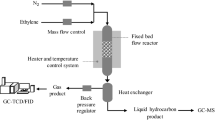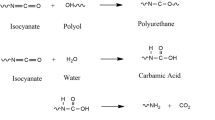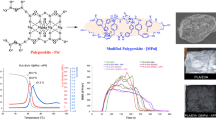Abstract
The synergistic effects of ZnCl2 on polypropylene (PP)/ammonium polyphosphate/pentaerythritol have been studied. The cone calorimeter test, limiting oxygen index, and UL-94 data show that suitable amount of ZnCl2 can greatly increase the flame-retardant property of PP/intumescent flame retardant (IFR)/ZnCl2 blends, however, the corresponding smoke release increased for PP/IFR/ZnCl2 blends when compared with PP/IFR without ZnCl2. The dynamic Fourier transfer infrared spectra reveal that the ZnCl2 accelerated the formation of charred layers with P–O–P and P–O–C complexes which formed from burning of polymer materials. The morphological structures of charred residues observed by scanning electron microscopy give the positive evidence that ZnCl2 can promote the formation of compact intumescent charred layers and prevent the charred from cracking, which effectively protects the underlying polymer from burning. The thermogravimetric analysis data show that the PP/IFR/ZnCl2 sample has higher thermal stability than that of PP/IFR and PP/IFR/ZnO samples. However, the corresponding charred residues are much lower than that of PP/IFR/ZnO sample. All the above data indicated that the synergistic mechanism of ZnCl2 with IFR in PP system can be ascribed to catalyze effects in condense phase and serve as a radical scavenger in vapor phase.






Similar content being viewed by others
References
Yi JS, Yin HQ, Cai XF. Effects of common synergistic agents on intumescent flame retardant polypropylene with a novel charring agent. J Therm Anal Calorim. 2013;111:725–34.
Wang ZZ, Qu BJ, Fan WC, Huang P. Combustion characteristics of halogen-free flame-retarded polyethylene containing magnesium hydroxide and some synergists. J Appl Polym Sci. 2001;81:206–14.
Halpern Y, Mott DM, Niswarder RH. Fire retardancy of thermoplastic materials by intumescence. Ind Eng Chem Prod Res Dev. 1984;23:233–8.
Hendrickson L, Connole KB. Review of stabilization of polyolefin insulated conductor. Polym Eng Sci. 1995;35:211–7.
Xie RC, Qu BJ. Synergistic effects of expandable graphite with some halogen-free flame retardants in polyolefin blends. Polym Degrad Stab. 2001;71:375–80.
Liu Y, Yi JS, Cai XF. The investigation of intumescent flame-retardant polypropylene using poly(hexamethylene terephthalamide) as carbonization agent. J Therm Anal Calorim. 2012;107:1191–7.
Wu Q, Qu BJ. Synergistic effects of silicotungstic acid on intumescent flame-retardant polypropylene. Polym Degrad Stab. 2001;74:255–61.
Almeras X, Dabrowski F. Using polyamide-6 as charring agent in intumescent polypropylene formulations II: thermal degradation. Polym Degrad Stab. 2002;77:315–23.
Bourbigot S, Bras ML, Delobel R, Breant P. 4A zeolite synergistic agent in new flame retardant intumescent formulations of polyethylenic polymers—study of the effect of the constituent monomers. Polym Degrad Stab. 1996;54:275–87.
Lewin M, Endo M. Catalysis of intumescent flame retardancy of polypropylene by metallic compounds. Polym Adv Technol. 2003;14:3–11.
Marosi G, Anna P, Marton A, Bertalan G, Bota A, Toth A, Mohai M, Racz I. Flame-retarded polyolefin systems of controlled interphase. Polym Adv Technol. 2002;13:1103–11.
Marosi G, Marton A, Anna P, Bertalan G, Marosfoi B, Szep A. Ceramic precursor in flame retardant systems. Polym Degrad Stab. 2002;77:259–65.
Marosi G, Marton A, Szep A, Csontos I, Keazei S, Zimonyi E, Toth A, Almeras X. Fire retardancy effect of migration in polypropylene nanocomposites induced by modified interlayer. Polym Degrad Stab. 2003;82:379–85.
Marosi G, Bertalan G, Anna P, et al. Brazilian clays as synergistic agents in an ethylenic polymer matrix containing an intumescent formulation. J Therm Anal Calorim. 2007;87:661–5.
Wu N, Yang RJ. Effects of metal oxides on intumescent flame-retardant polypropylene. Polym Adv Technol. 2011;22:495–501.
Wickstrom U, Goransson U. Full-scale/bench-scale correlations of wall and ceiling linings. In: Babtauskas V, Grayson S, editors. Heat release in fires. London: Elsevier; 1992. p. 461–7.
Hirschler MM. Heat release from plastic materials in heat release in fire. In: Babrauskas V, Grayson S, editors. Heat release in fire. London: Elsevier; 1992. p. 357–422.
Qiu LZ, Chen W, Qu BJ. Morphology and thermal stabilization mechanism of LLDPE/MMT and LLDPE/LDH nanocomposites. Polymer. 2006;47:922–30.
Bugajny M, Bourbigot S. The origin and nature of flame retardance in ethylene–vinyl acetate copolymers containing hostaflam AP 750. Polym Int. 1999;48:264–70.
Tai Q, Richard KK, Yang W, Qiao Z, Song L, Hu Y. Iron–montmorillonite and zinc borate as synergistic agents in flame-retardant glass fiber reinforced polyamide 6 composites in combination with melamine polyphosphate. Composites A. 2012;43:415–22.
Beach MW, Rondan NG, Froese RD, et al. Studies of degradation enhancement of polystyrene by flame retardant additives. Polym Degrad Stab. 2008;93:1664–73.
Costa L, Luda MP, Trossarelli L. Mechanism of condensed phase action in flame retardants. Synergistic systems based on halogen–metal compounds. Polym Degrad Stab. 2000;68:67–74.
Acknowledgements
The project was supported by the Heilongjiang Province Natural Science Funds for Distinguished Young Scholar No. JC201220 and Natural Science Foundation of Heilongjiang Province No. QC2011C038.
Author information
Authors and Affiliations
Corresponding author
Rights and permissions
About this article
Cite this article
Ye, L., Zhang, Y., Wang, S. et al. Synergistic effects and mechanism of ZnCl2 on intumescent flame-retardant polypropylene. J Therm Anal Calorim 115, 1065–1071 (2014). https://doi.org/10.1007/s10973-013-3381-z
Received:
Accepted:
Published:
Issue Date:
DOI: https://doi.org/10.1007/s10973-013-3381-z




